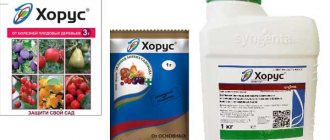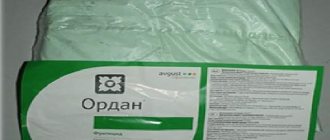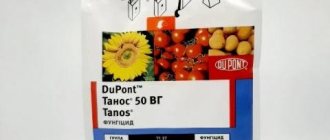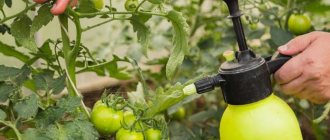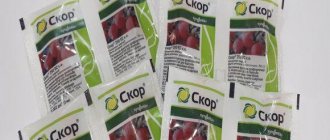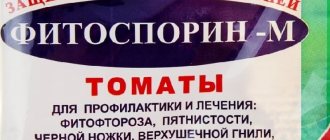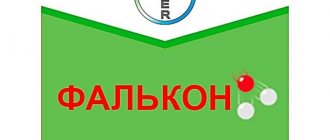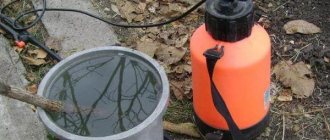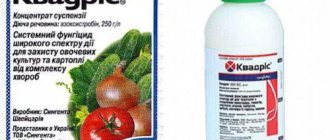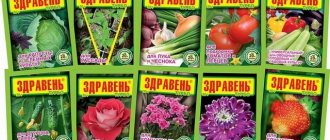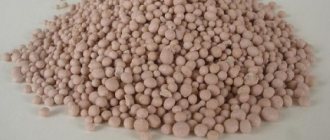In order to grow and harvest a decent harvest of vegetables and fruits on your plot, you need to carefully monitor the health of the garden. For this purpose, a number of new biological products have been developed and used, one of which is Glyocladin.
Its action is based on restoring the fertile properties of the soil and its disinfection by introducing special microbiological cultures. The use of this product helps to cope with the problems of diseases and pests in the most natural way, without disturbing the ecological cleanliness of the site.
Action of Glyokladin
The method of action of the fungi is that they penetrate the sclerotia of the pathogenic fungus and then gradually dissolve its cells from within.
In other cases, a fungus of the family Trichoderma harzianum encloses a colony of a pathogenic fungus with its hyphae and does not allow it to develop further, gradually suppressing it. In this case, Trichoderma does not enter into a symbiotic relationship with the roots of the plant. It remains in the soil as long as it contains carbohydrates. "Glyokladin" has versatile applications. In addition to treatment, it is used to disinfect the soil when planting seedlings in a permanent place or when picking them. The main advantages of the substance are as follows:
- restoration of normal soil microflora;
- actively stops the growth of pathogenic fungi;
- economical to use;
- does not linger in plants, when used you can get a clean harvest;
- safe for people, insects, animals.
indoor plants It fights best against putrefactive diseases, such as:
- Alternaria blight;
- late blight;
- verticillium;
- fusarium;
- rhizoctoniasis;
- Pythiosis.
Did you know? Trichoderma fungi are believed to produce substances that help plants develop and grow. Therefore, the drug has a positive effect on productivity.
The product has the greatest effect on constantly moist open soils, as well as for indoor plants whose soil cannot be overdried (azaleas, myrtaceae). Experienced gardeners and gardeners use two forms of the product: tablets for indoor plants and seedlings, and a suspension for large areas on the site. Then the soil does not turn sour and does not give off an unpleasant odor.
Mechanism of action
The main active ingredient of the drug is the mycelium of the Trichoderma fungus; when it gets into the soil, it begins to actively grow and multiply by spores. Favorable conditions for this are provided by a complex of special metabolites included in the composition.
Growing rapidly, the mycelium suppresses the development of pathogenic microflora in the soil, and colonies of pathogenic fungi envelop and kill, dissolving their cells from the inside. In this case, the plants do not suffer in any way; the fungus does not affect them and does not form a symbiosis with the root system.
Peculiarities:
- Trichoderma fungus culture develops best in a dark, damp environment at a temperature of 15℃ to 26℃, humidity 60-80%.
- Prefers slightly acidic soils with a high content of nutrients.
- The depth of the mycelium is from 1 to 7 cm, but not deeper than 8 cm.
- At temperatures below 14℃, the vital activity of the mycelium stops. All medicinal mycelium that grew on the site during the summer season dies with the onset of cold weather.
Instructions for use
When buying Glyokladin, it is important to understand how to use it correctly. First of all, you need to remember that it is not used for spraying plants.
It is used only for soil. At the same time, it retains its effect only in its upper layers, where there is access to air. Ideal conditions for it: depth no more than 8 cm, temperature +20-25 ° C, humidity 60-80%, acidity pH 4.5-6. Small deviations from these norms lead to the fact that the growth of fungal mycelium slows down significantly, which inhibits the effect of the drug.
For open ground plants
To use Glyokladin for open ground, the instructions recommend using one tablet of the drug per plant or per 300 ml of water when planting vegetables. If the product is used for a bush or seedling, depending on its size, give 3-4 tablets per plant.
Important! Glyokladin tablets do not dissolve in water.
Due to its insolubility in water, it is believed that the product is best used for small garden plants: seedlings, strawberries. On large plants its action is ineffective in case of disease. For them, it can only be used as a preventive measure.
To prepare a solution from the powder, take approximately 50 g of the product per 0.5 liter of water, which will be enough to treat a hectare of area. The suspension is poured into a watering tank and used for two hours until it loses its properties. After this, the soil is plowed to a depth of 25 cm.
For indoor plants
When replanting indoor plants, add one tablet of the drug per pot for one plant. However, if the pot is more than 17 cm in diameter, you will need three tablets. If the container is about 20 cm in diameter, you will need four tablets.
To combat fungal diseases for indoor plants, use: “Gamair”, Bordeaux mixture, “Fitosporin”, green soap, “Alirin”, “Trichodermin”.
Important! The mycelium of Trichoderma develops within 5–7 days, after which the suppression of pathogenic fungi begins. But the latter have been developing in the soil for a long time
Therefore, if Glyokladin does not help, most likely you are late with treatment.
Reader Questions
What is the price of Glyocladin?
The average cost of 100 tablets of Glyokladin is about 100 rubles.
Which manufacturers produce Glyocladin?
Glyokladin is produced by a well-known Russian company, which specializes in the production of biological products to combat diseases and improve soil composition.
Glyocladin and Fitosporin: what is the compatibility of the drugs?
Glyocladin is not used simultaneously with other chemical and biological fungicides. Therefore, it is better to use Fitosporin two weeks before using Glyokladin, or two weeks after.
Glyocladin or Trichodermin - which is better to use?
Both of these drugs contain the same active substance - the fungus Trichodermin. Therefore, use any of them for preventive purposes or to combat fungal diseases.
Trichodermin, gliocladin - video
Processing times
A biobactericide is a medicinal product, therefore, when using it, follow the instructions, dosages, and treatment times. Manufacturers in the description of Fitolavin indicate:
- doses of the drug on various plants;
- consumption during preventive and therapeutic treatments;
- side effects.
The stage of development and growth of the culture does not affect the application. A two-time procedure is recommended over 2 months with an interval of 14-15 days; on fruit trees up to 4-5 treatments are allowed. Interval – 14-15 days. This pattern is explained by the presence of pathogen resistance to Fitolavin. In addition, the product has a cumulative effect and accumulates in fruits and soil. Therefore, it cannot be used without taking into account dosages and timing of application.
If the area is healthy and no infection was observed in previous seasons, Fitolavin may not be used. Every year, only areas where infections regularly occur or if plants in neighboring areas are sick are treated.
Advantages of the drug
What can you say about the advantages of the biofungicide Glyokladin? It is easy to use - this is a very important quality. Another advantage and advantage is the one-time use: a one-time disinfection of the soil is sufficient, except in advanced cases.
The drug is safe for biological organisms: animals, birds, insects and humans.
Absolute harmlessness and lack of phytotoxicity are the main characteristics of the drug, which was developed by Russian scientists. No harmful substances accumulate either in the soil layer or in fruits and berries. The entire harvest from the site is an environmentally friendly product.
The advantages include:
- effective suppression and destruction of pathogenic soil flora;
- freeing plants from root/basal rot;
- lack of phytotoxicity and harmful effects on the environment;
- does not cause resistance, can be used continuously;
- does not accumulate in fruits and plant tissues, like chemical fungicides;
- prolonged effect - up to three months;
- improvement of the microflora of the fertile layer;
- improving the quality of fruits and roots.
The fungicide activates the development of cultivated seedlings. The drug also normalizes the biobalance of the soil after the use of agrochemicals.
When using counterfeit drugs, the disinfection effect will not be achieved: the gardener is just wasting time waiting for the result. The original version of the fungicide is produced only by AgroBioTechnology LLC.
While the mushrooms are fighting
Mushrooms are perhaps the quietest, but also the most violent of living organisms. Fungal diseases, judging by paleontological data, are capable of devouring a dinosaur the size of a steam locomotive. Many mushrooms also wage a life-and-death war among themselves.
Effect of Glyocladin on pathogenic fungi and plants
Fungi Trichoderma sp. They are warlike, but their natural targets of attack are plant-pathogenic fungi. Trichoderma know how to fight: at pos. 1 pic. it is shown how they, according to all the rules, surrounded the pathogenic fungus Fuzarium sp. (pink) on wheat residue. If the use of chemical fungicides is equated to area bombing, and biological products based on active ingredients to targeted strikes with “intelligent” weapons, then Gliocladin is already an army of disciplined soldiers fired upon; result (also on wheat) on pos. 3.
The most seasoned and hardy veterans are fully combat-ready only if they receive full allowances. Soil fungi obtain it from the soil. Actively developing plants are the main food competitors of lower fungi, so the use of Glyocladin will be effective in the future. cases (item 2 in Fig.):
- For sowing and planting seed (bulbs, tubers) - most effectively. Especially for seedlings in peat pots, see below;
- Before planting vitally active planting material (seedlings, rooted cuttings);
- When transferring indoor plants with a lump of earth into a large container (pot, container).
Glyocladin and picking
The use of Glyokladin when picking seedlings is completely justified. The pick for plants is stress is very weak and passes quickly: the primary taproot will die off one way or another. Picking plant seedlings can be compared to defloration (deflowering) women: it may be somewhat painful, but not at all scary and necessary for entering the age of maturity. Among some peoples (by the way, famous for their health, for example, the Polynesians), aboriginal women's health specialists regularly examine teenage girls and, when deemed timely, deflorate them through non-sexual means or give permission for marriage if there is already a groom. At the same time, there are no reasons for rumors.
Compatibility with other substances
The biobactericidal agent Fitolavin 300 can be combined with a large number of different agrochemical preparations. Combinations with highly alkaline compounds (pH above 8.5) are excluded.
Also, the drug is not used with some biological compounds, but is effective when used with Fitoverm, Alirin. After treatment with Fitolavin, it is recommended to treat the soil with Gamair or add any EM products.
Release form
Fitolavin is available on the market from two manufacturers (Russia):
- GreenBelt company produces a water-soluble concentrate, form – 2 ml, intended for treatment of indoor plants;
- Pharmbiomedservice LLC, volumes 50, 100, 400 ml (bottles), 1 and 5 liters (canisters) for garden and vegetable crops.
Analogues of the product
The following drugs are similar to Fitolavin in their mechanism of action on pathogenic microorganisms:
- Fitosporin (against fungal infections);
- Planriz (bacterial diseases);
- Baktofit (bacterial diseases);
- Gamair (against cancer, burns, necrosis);
- Alerin-B (root rot).
The drugs must be used strictly according to the instructions, taking into account toxicity and effectiveness.
Action of the biological product
Blocking of pathogenic microflora occurs due to metabolites contained in biological fertilizer. The interaction occurs as soon as the product enters the soil. The beneficial fungus instantly attacks pathogenic bacteria and significantly slows down their development. The negative effect of the drug is aimed directly at pathogenic organisms, while it does not cause the slightest harm to vegetable crops. Judging by the instructions for use and reviews, “Glyokladin” is a biological agent that has an incredibly fast action and is harmless to people.
How to properly use and consume a biological product
The instructions for use of the drug Glyokladin indicate that the tablets cannot be pre-dissolved in water. Once in a liquid environment, fungi will lose their properties. There is no need to crush tablets. It is this form of the drug that allows you to achieve the desired effect.
General rules for applying Glyocladin in tablet form:
- the soil temperature must be at least 14 °C;
- the soil must be pre-moistened and not allowed to dry out for 5-7 days;
- the tablet is buried (by no less than 1 cm and no more than 7 cm) manually. The drug acts only in the upper layers of soil enriched with oxygen.
The consumption rate for indoor plants is 1 tablet for every 300 ml of soil. For a flower bowl with a diameter of 15-17 cm, you need to use 3 pieces, placing them at the same distance from each other. In this case, 1 tablet is carefully buried as close to the root as possible.
More information about the use of the drug and its analogues is described in this video:
In open ground, for each hole for a plant or seedling, use 1 tablet, placed near the main root. It is possible to increase the dosage taking into account unfavorable weather conditions and washing out of spores by rain.
The drug is non-toxic and does not cause allergic reactions. It is recommended to avoid contact of tablets or solution with skin, store separately from food and not use food dishes or cutlery when working. The shelf life of Glyokladin without breaking the packaging is 2 years. Recommended temperature range – from -30 °C to +30 °C.
Preparation of a solution based on Glyokladin powder
The wettable powder in which the drug is produced is used for the prevention and treatment of root rot on cucumbers and tomatoes. One bottle (60 g) is enough to treat 1 hectare of plantings, the volume of liquid is increased to 1000 liters.
To prepare the working solution, mix the contents of the package into 5-10 liters of liquid, stirring for 2 minutes. Add a solution to a tank filled 1/3 with clean water, mix again and add liquid to the working volume. The preparation prepared for irrigation must be used within 4 hours. No further storage is provided.
The manufacturer recommends using Glyokladin powder for processing cucumbers and tomatoes in protected soil. After planting vegetable seedlings in the beds, 2 preventive waterings are carried out. The interval between applications is from 3 to 6 weeks. The decision on when to re-treat crops should be based on the condition of the crop (healthy or showing early signs of disease) and take into account weather conditions. The protective properties last for 2-3 months.
Using tablets when growing seedlings
The effect of the drug Glyokladin for seedlings is similar to the use of Fitosporin. The tablets protect vegetable and flower crops from the spread of fungal diseases and promote growth and development.
- Before sowing the seeds, place the drug in the container at the rate of 1 tablet per 300 ml of soil. The distance between them should be at least 1.5-2 cm.
- When planting seedlings in separate containers, place 1 tablet in each hole.
- When planting seedlings in a greenhouse or garden bed, 1-2 tablets are buried close to the root or on both sides of it.
It is worth remembering that the mycelium forms over several days in conditions of high humidity, sufficient aeration and at a temperature of 14 °C. If weather conditions favorable for fungal diseases are observed before planting seedlings, then the tablets can be added to the wells in advance, about 7 days in advance.
Terms and conditions of storage
In a sealed container, the fungicide fully retains its beneficial properties for six months from the date of manufacture. The drug must be protected from sunlight, high humidity, and sudden temperature changes. Do not store the drug at temperatures below -30°C and above +25°C. Opened packaging should be tightly closed after use. The finished working solution cannot be stored, as it very quickly loses its usefulness.
In the process of growing garden, vegetable and ornamental crops on a personal plot, it is extremely important to provide the plants with reliable protection from diseases caused by spores of various pathogenic fungi. In this matter, the effective and safe drug Glyocladin can become an indispensable assistant.
How to properly dilute the solution
The working composition is made immediately before treating the seeds or spraying the plantings.
The standard dosage is 2 ml per liter of warm water. Consumption is determined by the type and age of the crop, the type of treatment (prevention, therapy), and the area of plantings.
Preparation procedure:
- Approximately 1/3 of water is poured into the container;
- add the required amount of Fitolavin;
- stir until a homogeneous solution is obtained;
- take a small amount of water at room temperature;
- add water to the required volume.
Fitolavin VRK (water-soluble concentrate) is suitable for spraying in drip irrigation systems. Mother liquor (MS) is not used for drip irrigation systems due to the formation of a suspension.
Processing rules:
- It is advisable to choose evening hours when the heat subsides;
- dry day;
- spray gun setting – “fog” (fine dispersion).
Spray the above-ground parts of plants until a thin film appears. During treatment, the soil near the plantings is also moistened.
Dosage, application and timing for various crops
For preventive purposes, seed material is treated, treatment is carried out at the first symptoms of the disease.
Fitolavin is used at different stages:
- processing of planting material;
- spraying seedlings (in the phase of appearance of 2-3 true leaves);
- at any phase of plant growth;
- after harvest.
When to process (recommended schemes):
- soaking of seed material (standard solution) is carried out for greenhouse tomatoes, cabbage, eggplants, peppers - one hour;
- immersion of potato tubers before planting - for 30 minutes;
- watering seedlings (peppers, greenhouse cucumbers, greenhouse tomatoes, eggplants, cabbage) - in the phase of 2-3 leaves, 40-50 ml of solution per bush;
- after planting the seedlings in a permanent place - 100-200 ml per bush.
Scheme for using Fitolavin for diseases:
- bacteriosis – watering, 2 treatments allowed (adult plants), seedlings – one treatment;
- Infectious blossom end rot - spray twice;
- black leg - one-time treatment;
- late blight – one treatment before flowering;
- Alternaria - one spray before the formation of buds;
- angular spotting - when the first signs appear, one treatment of plants;
- Root collar necrosis – watering, 2 procedures.
Onions are sprayed against pink root rot, gray and soft bacterial rot, and for fusarium bottom rot. Up to 3 treatments are allowed. Houseplants and flower seedlings are watered when the first symptoms of disease appear.
In the garden they treat pear and apple trees against moniliosis, scab and fire blight. Sprayed in the phase of budding, flowering, as well as in the stage of formation of the ovary, fruits (2 cm in diameter, 4 cm in diameter), after the leaves have fallen.
Preparation and processing
Use of tableted "Glyokladin"
Tablets of the drug "Glyokladin" are placed in the soil to a depth of 1-1.5 cm. in dry form, without dissolving in water.
Dosage - one tablet per plant/hole, or - one tablet per 0.3-0.8 l. soil.
The application rate is once.
| Dosage | Culture | Pest | Features of application | Waiting period/number of treatments |
| 1 tablet per well | Tomato and cucumber crops, seedlings of these crops | Root rot, “black leg” - root rot. | It is applied to the soil manually when planting seeds, picking seedlings and final planting of seedlings. | -/1 |
| 1 tablet per 0.3-0.8 l. soil | Indoor flower plants, flower seedlings | Root and basal rot | When sowing seeds, picking and planting seedlings, as well as when transplanting flowers. | -/1 |
Use of powder or suspension concentrate
The working solution is prepared according to the instructions; it simply involves diluting the powder or concentrate with water.
It is recommended to use the liquid preparation "Glyokladin" once in the spring and 7-10 days after steaming the soil in the greenhouse. The soil is treated by either pouring or spraying. Then they dig to a depth of 20-30 cm to evenly distribute Trichomerma fungus spores throughout the entire depth of the arable layer.
During the entire growing season, it is possible to re-apply liquid “Glyokladin” if the appearance or spread of putrefactive plant diseases is observed. To do this, either spill all the soil in the greenhouse, or locally water the plant at the root. The frequency of treatments per season can reach two or three.
It is recommended to use the working solution for no more than 3-4 hours.
| Dosage | Culture | Pest | Features of application | Waiting period/number of treatments |
| 60-140 ml./hectare, or 10-20 l./100 m2 of working solution | Protected soil tomatoes and cucumbers | Rot (root rot, basal rot), tracheomycosis wilt | Spraying or spilling soil, with mandatory embedding of the solution into the soil | -/1-3 |
Two important points should be noted:
1) the drug begins its effect when using a liquid solution immediately, and when using tablets 7 days after application to the soil;
2) the period of protective action of “Glyokladin” with a single application reaches 2-3 months!!!.
Trichocin SP: application
Trichocin SP is a BIOFUNGICIDE that is used against:
- root and basal rot during the growing season.
The peculiarity of the drug is that it is used for shedding soil in a greenhouse and open ground in spring, summer or autumn. The powder dissolves easily in water, and this quality is convenient to use for spring and autumn soil disinfection.
Glyocladin and Trichocin SP - what is the difference? Both drugs are based on the fungus Trichoderma harzianum, but are available in different forms: the first is in the form of tablets, the second is in powder form. In addition, Trichocin is characterized by an increased concentration of substances.
Application procedure
All antibiotics can accumulate in fruits. Therefore, regular annual use of phytolavine should still be avoided, although it is slightly toxic to humans and is used in microdoses. Phytolavin, depending on the air temperature, begins to act 1-2 days after treatment. The effect of the drug lasts 50 days at an external temperature of +12 and 10 days at +30. Accordingly, in order to avoid the accumulation of PTM in fruits, an interval between treatments is set from 60 to 15 days. It is permissible to carry out 2 treatments per season. The exception is fruits with thick skin, such as apples. You can treat the apple crop from fire blight and moniliosis with 5 treatments with phytolavine at an interval of 2 weeks. In this case, the crop must be washed before consumption or sale. The treatment procedure is watering or spraying according to the usual rules: in the evening in calm, preferably cloudy weather; small “foggy” stream; A continuous film of drizzle should settle on the plants. When the first droplets appear, stop processing the current area and move on to the next one. Therapeutic and prophylactic irrigation with phytolavine is also carried out according to the usual method - into pre-moistened soil.
Prevention of cucumber diseases
There is no need to wait until the plant shows signs of disease. It is better to start using natural remedies for preventive purposes in order to prevent the proliferation of pathogenic microbes.
To protect cucumbers from black rot, Glyokladin tablets are used. Their number can vary from 1 to 3 pieces. depending on the size of the bush. Apply the product from different sides and inject it 1 cm into the soil. It is important to know that the product will not work in a deep layer of soil.
Features of application
The Glyokladina mushroom needs time to emerge from suspended animation and grow. In the temperature range of 21-23 degrees, this requires 3-4 days; in the range of 20-25 degrees a week, this is the waiting time for the drug to take effect. Below +20 and above +25 Celsius, Trichoderma in pure culture awakens and grows, but in real conditions it turns out to be unable to suppress pathogenic fungi; on the contrary, it itself is inhibited by them - Glyocladin loses its effectiveness outside the specified optimal temperature range.
For successful development, Trichoderma also needs an environment saturated with organic matter and permeable to air: it is useless to add Glyocladin to sandy loams and sands, clays and loams, fallow or poorly cultivated compacted soils. Optimal soil moisture is 60-80%. In drier conditions, the mushroom wakes up sluggishly and does not do its job; in more humid conditions it awakens vigorously, but quickly dies, giving rise to spores. In water-filled soil, dormant trichoderma generally rots before it has time to awaken.
The duration of the drug in all cases is 50-85 days: the longer, the lighter the soil, and its humidity and temperature are closer to the minimum values within the optimum. Keeping in mind the need for air, Glyokladin tablets should be placed at a depth of 5-8 cm: higher - it will overheat and dry out; deeper - it will suffocate. The preparation is laid deeper on lighter soils; smaller on denser ones.
Glyocladin, Trichocin and acidity
There are several species of mushrooms of the genus Trichoderma. Glyocladin is made from the VIZR-18 strain of the Trichoderma harzianum species, see video:
Video: about Gliokladina
https://youtube.com/watch?v=v29TQVMgBTY
There is also an analogue of Glyocladin Trichocin on sale. It is made from the mushroom Trichoderma lignorum. Under optimal real-life conditions, Glyocladin is more effective: it suppresses all of the above pathogens, while Trichocin successfully copes only with Phytophthora infestans, see story:
Video: Glyocladin and Trichocin
However, Trichocin in relation to Glyokladin is not at all the same as “China” and “company”. The fungus Trichoderma harzianum has a serious drawback in this capacity - it needs an acidic environment for normal development: pH = (4.5-6). Already in neutral soil with pH = 7, the development of Trichoderma harzianum is suppressed, and at acidic pH
in living open soil, Trichocin may be better than Glyocladin.
Compatibility
Glyocladin is incompatible with any other agrochemical and plant protection products. If they have been used previously, Gliocladin can be used no earlier than the expiration date of the predecessor product. After Glyokladin, no earlier than a week after its application, you can use preparations of similar action to protect the apical (aerial) parts of plants: Alirin, Gamair and Planriz. The use of Glyokladin with Alirin and Gamair is especially effective, see video:
Glyocladin: what diseases is it used for?
Basically, the fungicide Glyokladin is intended to combat the following diseases:
- with root rot;
- pythiosis;
- rhizoctoniasis;
- fusarium;
- when the soil is contaminated with any types of mold;
- with root powdery mildew, including downy mildew;
- diseases affecting the above-ground parts of plants (foliage, stems) - gray rot, ascochyta blight, alternaria blight, anthracnose.
Is there Trichoderma in GLYOCLADIN? - video
Gliocladin is also used for late blight.
Action
Preventive effect of phytolavine on plants
The active principle of phytolavin is the so-called. FTM (phytobacteriomycin) is a complex of streptothricin antibiotics. FTM is a product of the struggle for survival of soil mold fungi; in this it is similar to penicillin and other antibiotics. The chemical basis of FTM is somewhat similar to that of biomycin and streptomycin, but is “targeted” at plant pathogenic microorganisms. Disputes between “our own” people, i.e. the presence of F is other fungi, and FTM simply kills harmful bacteria. Its effect on beneficial soil bacteria is weaker, but FTM still inhibits them, so after adding phytolavine, the soil needs to be replenished with living biological products. In a small private farm or greenhouse, it is often enough to add more affordable purchased or homemade EO preparations, see below.
Media Compatibility
It is forbidden to use such a drug in conjunction with chemical fungicides and pesticides, since in this case the additional agents block the action of Trichoderma, and in some cases even destroy the beneficial fungus.
After deepening the capsules with active substances in the composition, the use of fungicides should be abandoned for at least several weeks. also prohibited to use the drug in combination with other products that contain strains of this fungus. It is allowed to start taking them only after five days from the date of use.
Together with this remedy, the drug Planzir is approved, which has a bactericidal effect, inhibiting the effect of bacterial rot.
Purpose of the drug and its benefits
The drug is used as a medicine for representatives of garden and home flora, and in addition - to disinfect the soil in which seedlings and plants are planted, which need to be provided with a new “housing” during picking.
With the help of Glyokladin you can disinfect the soil.
Diseases that Glyokladin can treat:
- late blight;
- rhizoctoniasis;
- ascochyta;
- athracnose;
- Alternaria blight;
- fusarium;
- pythiosis;
- verticillium.
Why do gardeners and flower growers increasingly prefer this drug? Judge for yourself:
- it effectively fights pathogenic fungi;
- restores the correct soil microflora;
- is used sparingly;
- can be used for preventive purposes;
- used both outdoors and indoors (for treating indoor plants);
- safe not only for humans, but also for animals and pollinating insects;
- the resulting harvest (when processing fruit, berry and vegetable crops) is environmentally friendly.
General characteristics of the biological product
The biological product "Glyokladin" has a wide range of actions. It effectively fights any manifestations of fungal and bacterial diseases that can affect crops grown in gardens and greenhouses.
The active ingredient of the product is the fungus Trichoderma harzianum VIZR-18. It is this that suppresses the development of pathogenic microorganisms, the vital processes of which can destroy most of the crop.
The drug has a fast effect. Within 3-7 days after treatment, the gardener can notice an improvement in the condition of plants that were affected by one or another disease. The speed of action of a biological agent directly depends on weather conditions.
The drug can be seen on sale in the form of tablets and powder.
Glyocladin mushroom tablets
Glycladin is sold as tablets in packages of various capacities (see figure below). Unlike most, if not all, widespread biological plant protection products, Glyocladin tablets are not an active substance or complex of substances isolated from the producing organism, but dry compressed hyphae of beneficial soil fungi of the genus Trichoderma. Once in favorable conditions, the “sleeping” mushroom awakens, grows and does its job.
Forms of release of the plant protection drug Glyokladin
Mushrooms, as you know, are not autotrophs - they are not capable of synthesizing organic matter from mineral substances. Therefore, mushrooms do not consume nutrients, but ready-made nutrients; most of all carbohydrates (starch, sugar). Mushrooms' extraction of energy from nutrients requires a chemical agent to oxidize the food. Fungi Trichoderma sp. They are served, like you and me, by oxygen - they are aerobes, i.e. need air to breathe. But, unlike many higher soil fungi, Trichoderma sp. not symbionts: they live and develop on their own, without entering into mutually beneficial cohabitation with plants. It follows that the use of Glyocladin and its analogues (see below) should be carried out subject to the following general conditions:
- It makes no sense to reject Glyocladin according to the principle “the whiter the better.” The normal color of its tablets is greenish-gray, on the right in Fig. A fake is recognized, alas, only by the absence of action.
- The tablets of the drug do not dissolve and do not soak! Statements that Glyocladin is produced in the form of a concentrated emulsion of EC or a water-soluble concentrate of VRK, or that they can be prepared independently from tablets, are, excuse me, either ignorant nonsense or a deliberate deception. By putting a Glyocladin tablet in water, you will simply drown the mushrooms.
- Also, Glyokladin is not available in sticks (sticks for sticking into the ground). A stick as a plant protection product is a porous (possibly soluble) rod impregnated with an active substance, which it gradually releases into the soil. If someone decided to make Gliocladin sticks, the effect would be the same as from treating frostbite in parts, starting from the fingertips - nothing but gangrene.
- Fungal hyphae are much less persistent than spores. After being forced into suspended animation and remaining in it for a long time, the hyphae do not fully come to life. A Glyocladin tablet is the minimum “critical mass” for the revival of the fungus. By the end of the shelf life of 2 years, a viable core still remains in it, but it is impossible to crush or split the tablets or crush them into pieces in other ways - even if the pieces of hyphae come to life, they will be suppressed by competitors.
- Glyocladin is effective only for young plants: stronger adults with their secretions will not allow the fungus to develop properly.
- For root crops and perennials in open ground (including herbaceous plants that overwinter in underground parts), Glyokladin is not very effective.
- Glyocladin used for plants, incl. very young, experiencing or just experienced stress: they “desperately defend themselves” with their secretions, not discerning who is useful to them and who is harmful.
- The effectiveness of Glyokladin strongly depends on the type and strain of the fungus, as well as the external conditions of use of the drug, see below.
- On open ground, the dose of Glyokladin should be increased, keeping in mind the possibility of worsening external conditions. This will not harm the plants and the quality of the harvest in any way - the “extra” hyphae simply will not survive and will quietly disappear into the soil.
Analogues and substitutes of the drug
If it is not possible to purchase Glyokladin, you can use other fungicides. Before considering analogues, it is worth pointing out drugs with similar effects under other names:
- Oktyabrina Aprelevna;
- Inta-Vir;
- EcoMaster.
This is the same Gliocladin, but under a different name. These drugs are produced by other companies in agreement with AgroBioTechnology LLC.
Analogues include drugs:
- Trichodermin;
- Fito-M;
- Trichoderma veride;
- Trichosan;
- Trichophorus;
- Trichocin.
Trichodermin and Trichoderma veride
Trichodermin and Trichoderma Veride are biofungicides with an innovative formula. These are preparations of a new generation of fungicides that are environmentally friendly and safe for the surrounding flora and fauna. The use of biofungicides does not spoil water bodies, does not poison fruits with chemicals, and does not destroy living beings within a radius of several kilometers. These preparations contain in their formula beneficial soil microorganisms - the fungi Trichoderma lignorum. Due to their safety, biological products have completely replaced their chemical counterparts.
Unlike agrochemicals, biological products stimulate the development of plants, increase their immune status and have a positive effect on the taste characteristics of fruits.
Unlike Glyokladin, these drugs fight not only basal/root rot. But also with late blight, leaf curl, powdery mildew and many other plant diseases. The beneficial effect of the drugs affects the structure of the soil: they restore the biobalance in the soil after the use of agrochemicals.
Trichodermin works as a soil fertilizer, as it decomposes organic and chemical elements into their components. This enriches the fertile layer with microelements.
The preparations are used when planting crops in holes in the open ground, when treating seeds, to prepare the soil for replanting plants and for other garden work with seedlings. The preparations are also suitable for treating indoor plants and flowers. It is interesting to use photos of mushrooms in cosmetology to strengthen hair and other beneficial effects.
Fungi antagonists of Trichoderma lignorum behave very aggressively towards competing fungi, which are pathogenic myceliums in the soil. When it enters an environment favorable for development, Trichoderma lignorum begins to actively spread and displace other mycelium. As a result, there will be a powerful suppression of pathogenic microflora and a total spread of beneficial fungi.
Like Trichoderma, the fungus Trichoderma lignorum secretes antibiotics that disinfect the soil and heal the roots/roots of plants. To activate the vital activity of the fungus, the preparation contains a grain substrate and a vitamin complex.
Fito-M
The drug Fito-M is a full-fledged analogue of Glyokladin. The drug contains the fungi Trichoderma lignorum and bacteria Bacillus subtilis. Fito-M works no worse than chemical fungicides, destroying pathogenic strains. The activity of antagonistic fungi shows high efficiency in disinfecting the soil layer. The fertility of the land increases while the environment remains intact.
Unlike Glyokladin, Fito-M fights bacterial infection, so the scope of the drug is much broader. The biofungicide can cope with many diseases:
- late blight;
- septoria;
- seed mold;
- brown rust;
- many other diseases.
This fungicide works with all types of plants in the garden: fruits and vegetables, berry bushes, grains and legumes, fruit trees, ornamental plants. The drug is also used to save indoor plants from various phytodiseases.
Fito-M is used for:
- prevention of the occurrence of phytodiseases;
- stimulation of development and growth;
- preventing relapse of diseases;
- increasing the shelf life of the crop;
- improving the taste characteristics of fruits and berries.
To treat the area, use an aqueous solution: water and spray the plants.
Composition, formulation and manufacturer
The active ingredient of Glyokladina is the mushroom Trichoderma harzianum, strain 18 VIZR.
- "Glyokladin" in tablet form
- "Glyocladin" in the form of a wettable powder
- "Glyokladin" in the form of a suspension concentrate
- 1000 tablets "Glyokladina"
The drug is available in the following forms:
- “Glyokladin-tab” in tablet form in plastic jars of 1000 pieces, or cardboard packages of two types (for vegetable crops or for flower crops) of 100 tablets each;
- “Glyokladin-SP” in the form of a wettable powder, packaged in a 60g plastic jar;
- "Glyokladin-SK" in the form of a suspension concentrate in 5 liters. canisters
Manufacturer and registrant - Russian.
Gamair: application
Gamair is a BIOBACTERICIDE and BIOFUNGICIDE that is used against:
- bacteriosis, spotting, bacterial cancer and rot (bacterial diseases),
- scab and moniliosis (fungal diseases).
This drug prevents the development of bacterial and fungal diseases of seedlings and adult plants. Available in tablet form.
The literature recommends the combined use of Alirin and Gamaira. Due to complex processing, the range of pathogens that can be eliminated is expanded.
Safety precautions when working with Glyocladin
The biological agent is classified as a class 4 drug for human health. It is completely non-toxic to plants. Thanks to this, it is allowed to be used near bodies of water.
If a person accidentally swallows a Glyocladin tablet, then after a while he will begin to experience nausea, vomiting, diarrhea and anaphylactic shock. To avoid unpleasant consequences, you must immediately perform gastric lavage and seek help from a qualified specialist.
The product must be stored in a dry place. Under no circumstances should it be placed in the same place as food or medicine. Small children and pets should not have access to it. The drug can be stored for 2 years. Afterwards, it loses its properties and becomes unsuitable for treating seedling beds.
"Glyokladin" is an ideal remedy that helps prevent diseases of vegetables and houseplants, without having a detrimental effect on them. Hundreds of gardeners have already seen the effectiveness of this biological product.
Glyocladin: reviews from gardeners about the use of the drug
Unfortunately, there is no one effective pill that could defeat all diseases that affect crops. But recently, gardeners and vegetable growers have given preference to biological fungicides
, which are the safest to use and do not harm the environment. That is why Glyocladin is such a popular drug for many fungal diseases.
Read also Beautiful name for a stallion
Gliocladin from Oktyabrina Aprelevna - video
In some regions it has become difficult to buy the ancient microbiological drug Trichodermin. But they began to replace it with a replacement - Glyokladin. It is recommended for use on all crops: from indoor flowers and seedlings to fruit trees and shrubs.
The new product is produced in jars of one hundred tablets or in a cardboard blister of two bags of 50 tablets, which contain dried fungal hyphae. This fungus is so difficult to get along with other fungi that as soon as it is introduced into the soil, it begins to drive everyone out. At the same time, such communal dismantling only benefits the roots of cultivated plants.
The mechanism of action of Glyokladin is complex. Roughly speaking, the active substance (fungal culture Trichoderma harzianum VIZR-18) penetrates the bodies of parasitic fungi and slowly dissolves them from the inside. It is not difficult to guess that this is a close relative of the drug Trichodermin. However, it is believed that Gliocladin acts stronger and faster, and is more aggressive. Especially when it comes to root rot.
Trichoderma is active only in the upper layers of the soil. It is useless to spray the tops with its solutions; the drug only works when applied to the soil. The fungal killer grows fastest at temperatures in the +20 range. +25° C and acidity from 4.5 to 6 pH.
The tablets do not dissolve in water. They need to be placed in the soil when transplanting seedlings into pots or holes. The tablet is designed for 300 g of soil; three tablets will be needed for a pot with a diameter of 15 cm; For a pot with a diameter of 20 cm you will need four pieces.
When planting seedlings in the ground, three to four tablets are placed in each hole, depending on the size of the bush. Try to place the tablets as close to the roots as possible.
Gliocladin most powerfully destroys late blight, displacing it from the soil. But other harmful fungi, even if they are not completely driven out, slow down their development and significantly reduce their harmfulness.
Noting the high effectiveness of Glyocladin, scientists are in no hurry to declare that it will completely replace Trichodermin - there are diseases against which the latter drug works faster and stronger. Therefore, buy what you have in stores. Both fungi are quite picky about their neighbors and will displace, if not all harmful microflora, then most of it.
Glyokladin tablets do not dissolve in water, they are effective and justified only when planting, replanting small plants, for example, when propagating strawberries or planting seedlings, but are useless for large plants. If you have diseased large bushes, we advise you to consider treatment with other drugs, preferably in liquid form, so that you can properly shed the soil (Fitosporin, Trichophyte, etc.).
Since Trichoderma requires the presence of free water, the use of preparations based on it is advisable on constantly moist soils and can be useful for those indoor plants that must grow in a moderately humid environment without drying out, but there is always a risk of flooding (azaleas, myrtaceae).
Glyocladin has a fourth class of hazard for humans (low toxicity). Not phytotoxic.
The drug should be stored in a dry room, optimally from +5 to +15° C, exclusively in a dry place, separate from food products and medicines, in places inaccessible to children and pets. Shelf life is two years.
Instructions for use
When purchasing a biological product, you should remember that it is used only for watering the soil. Plants cannot be sprayed with the prepared solution.
Glyocladin tablets do not dissolve in water, so they are simply placed in the soil. A suspension should be prepared from the powder, for which 50 grams of the drug are diluted in one liter of water. The prepared solution must be used within the next two hours. One liter of suspension will be enough to water an area of one hectare.
Using tablets for indoor plants
It is very convenient to use tablets to prevent diseases in home flowers.
It is enough to place the required number of tablets in the ground and moisten the soil in a timely manner. The tableted drug will gradually dissolve and have a positive effect. It is recommended to add Gliocladin to the soil when transplanting flowers; I use three tablets for pots with a diameter of 17 cm. If the pot has a diameter of 20 cm or more, then you will need four tablets.
If the plant is not planned to be replanted, then the tablets are simply pressed into the ground, placing them at an equal distance from each other. Tablets cannot be immersed deeper than 7 cm into the soil.
Seedling protection
Vegetable seedlings in the early stages of development are very weak and therefore are often exposed to various diseases. Glyocladin can be used to protect plants:
- Before sowing seeds, the preparation is buried in the soil, using one tablet for a 300 ml container.
- During picking, one tablet for a 300 ml pot is also used.
- After transplanting the plants into open ground, one tablet is pressed into the soil near the root system of each bush.
The tableted drug begins to act within the first week and protects the plantings for two to three months.
Phytolavine compatibility
Fitolavin is compatible with most agrochemicals, except those that create a highly alkaline environment with pH>8.5, i.e. with stove ash and fertilizers based on it. Incompatible with many biological products, especially Lepidocide. Compatible with Alirin, Bitoxibacillin, Gamair and Fitoverm. If EO preparations or EO compost are used to replenish the soil with bacteria after phytolavine, they must be applied to the roots of plants, from where the active substance of phytolavine has already been used for its intended purpose. Compost does not need to be mulched; it is distributed in a thin layer over the surface of the soil and sprinkled with fresh soil.
Technical compatibility
Conventional phytolavin labeled MP (mother solution) forms a thin suspension in an aqueous working solution and therefore is not applicable in drip irrigation systems - nozzles, valves and dispensers become clogged. Fitolavin VRK (water-soluble concentrate) is produced for drip irrigation. Fitolavin VRK is also supplied to the retail chain under the designation Fitolavin-300.
Precautionary measures
Phytolavin is a substance of the 3rd hazard class. It has a weak effect on bees: they can be released 12 hours after treatment with phytolavine, so this product is applicable during flowering of plants. In humans, phytolavine can cause irritation of the skin and mucous membranes, and if ingested, antibiotic poisoning. In general, phytolavin is low-toxic for warm-blooded animals, so it is not necessary to wear a full set of PPE to work with it: clothing that covers the body, latex gloves for hands, glasses and a hat are sufficient, see Fig..
Minimum set of personal protective equipment for working with phytolavine
However, in the aquatic environment, in the presence of organic compounds, PTM forms persistent and much more harmful complexes, therefore, the entry of phytolavine into water supplies and open reservoirs is unacceptable. In a humid and warm greenhouse atmosphere, the effect of PTM on a person increases, and to work with phytoavalanche in a greenhouse, it is advisable to wear a plastic raincoat with a hood with an elastic band and protective goggles over work clothes. In this case, a regular petal respirator can serve as a means of respiratory protection. First aid measures if phytolavine gets on the body and into the body are as follows:
- If it gets on the skin, rinse with water, wash the affected area with water and 60% or 72% laundry soap (not with synthetic detergents or white laundry soap!) and rinse again with water.
- In case of contact with eyes, rinse them open under running clean water.
- If it gets on your lips or in your mouth, rinse 3-4 times and spit. Rinse the mouth, not the throat, i.e. keep your head tilted down.
- If ingested, drink 3-4 glasses of water, stirring one pharmacy activated carbon powder in each and induce vomiting.
